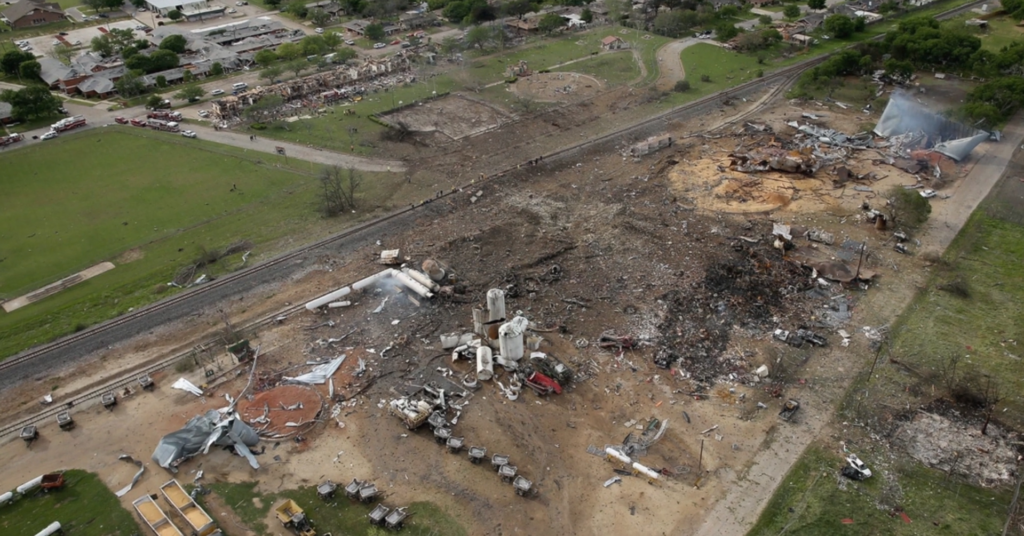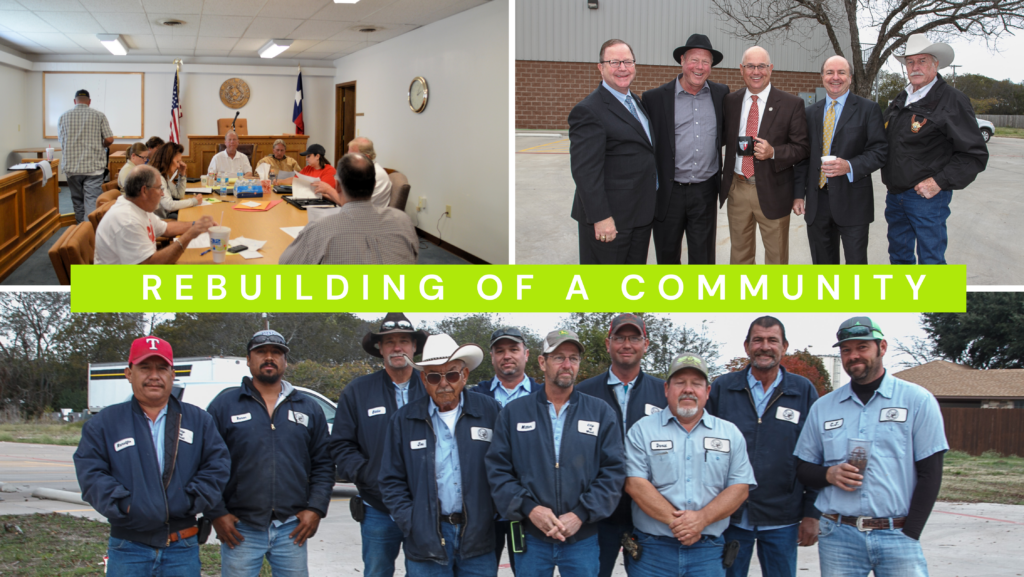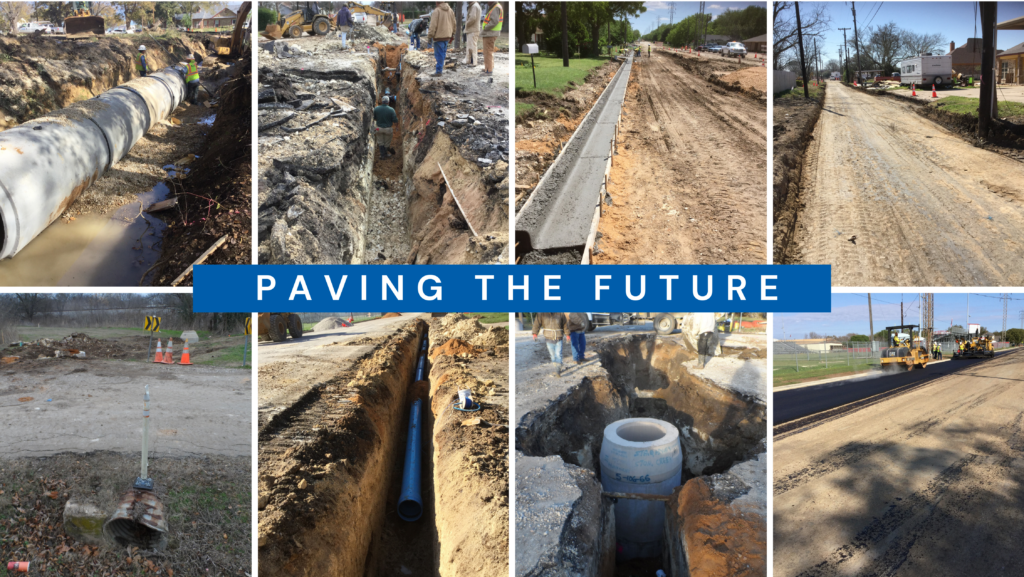Ten Years of Rebuilding and the City of West is Better Than Ever
Author: Megan Gilmore | Walker Partners
April 2023

Civil engineering is powerful. It’s impactful. But it’s often made up of a thousand little things that most people don’t even realize are important – until it’s no longer working. To the untrained eye, it’s just a road, a bridge, or water running to do the dishes. But when the road is demolished, or half of your town no longer has clean drinking water, it’s no longer just a road but a critical piece of livelihood for a community. There are times in our careers when you witness firsthand the powerful impact of our work. At times that impact is about the very lifeline of a community. After a tragic fertilizer facility explosion devastated the City of West, TX, they not only faced the grief of lives lost, serious injuries, and damages to homes, schools, and businesses, but they also had to quickly repair life-sustaining infrastructure. To mark the 10th anniversary of the tragedy, Walker Partners created a short documentary to give the community as a gift. The film not only honors the tragedy and the lives lost, but also celebrates the resolve of the community and how far they’ve come. It took strong relationships, incredible teamwork, and innovative engineering to get the resilient community back on its feet and thriving for generations to come. To watch the film, go to WestTXRisingfromRubble.com
HISTORY OF WEST A small rural community along I-35, West, Texas, is known for its kolaches and their friendly people. The town started back in the 1800s as an old railroad town and developed along the railroad tracks as Czech and German immigrants settled into the area. When the West Fertilizer facility was established, it was about a half mile north of the town. The City grew and expanded north, filling the area with neighborhoods, a park, a nursing home, apartments, and churches. There was no reason to worry about the facility at the time. The plant didn’t make fertilizer, it sold fertilizer by bagful to farmers. Over the years, it morphed into a mixing plant, bringing in bulk chemicals to develop custom mix fertilizer for the area farmers. At the heart of the fertilizing season, the fertilizer facility had more chemicals on hand during April than in any other month.

THE EXPLOSION
On April 17, 2013, at 7:29 pm West Fire Department was called out to fight a fire at West Fertilizer. The people of West stood in awe as they saw massive black clouds of smoke engulfing the plant. Shortly after, the City of West was rocked by an explosion causing damage to a 37-block area, almost half of the small town. It was estimated that 28-34 tons of ammonium nitrate exploded, equivalent to 15,000 to 20,000 pounds of TNT. The blast measured as a 2.1 earthquake on the Richter scale and left a crater that was 93 feet wide and 10 feet deep, about the size of an Olympic swimming pool. The explosion resulted in 15 casualties (12 of those emergency personnel), hundreds injured, and a large portion of the town destroyed. An apartment complex was demolished, the park was gone, over 120 homes were destroyed, and even the supports? of the schools were completely bent.
All volunteer firefighters themselves, the Mayor, Mayor Pro Tem, and the Director of Public Works, had to quickly shift from fighting the blaze to managing the fallout of the explosion, while also making sure their own families had a safe place to stay. Emergency crews from surrounding areas stepped in to fight the various fires across town, handle triage, and transport patients across the local area. “No city, no mayor, no city council, no public works director is ever prepared for anything like that. There is not a checklist to go by, there’s not a book or a manual. It is absolutely designing and building the airplane at 30,000 feet,” said Jed Walker, President of Walker Partners.

THE DAMAGE
Director of Public Works, CJ Gillaspie, immediately started zoning off the City. Gillaspie and his crews started shutting off water and utilities to zones 2 and 3 – the more heavily damaged areas – while trying to maintain water service to zone 1 where residents were still living – and in many cases, had taken in friends and relatives who lived in the other zones. Prior to the blast, the entire town was on one valve for gas utilities. Gillaspie also worked with Atmos Energy to install a shut-off valve for zones 2 and 3.
At the time of the fire, West’s primary water source, a Trinity Aquifer groundwater well, was out of service for maintenance. West’s emergency water supply, an 18-mile long, 12-inch diameter pipeline from the City of Waco, could not keep up with the demand to extinguish the flames. As if conditions could not get any worse, the firefighters and Public Works crews soon discovered that the explosion had destroyed the 150,000-gallon Ground Storage Tank and Booster Pump Station at Well No. 4. Many streets were severely fractured and a 250,000 gallon GST was badly damaged. Approximately one-fourth of the underground water distribution system was compromised or destroyed by the tremors resulting from the explosion. “It didn’t make any difference whether it was a water tank or a house or an apartment complex, it damaged everything. It looked like a bomb had hit some of them. Much debris. Much confusion. It was worse than a hurricane ever dreamed about being. It was just total chaos for a long time,” said Kyle Botkin, former Construction Manager for Walker Partners. Kyle was on the scene within days of the explosion to help the City determine infrastructure damage.
WHAT COULD HAVE BEEN
As bad as the damage was, it could have been worse. Fortunately, it was a Wednesday night so most of the town was at Wednesday evening church services on the south side of town. It was also after school hours and there were no school functions that night. Structurally, an 8-foot-high railroad embankment between the facility and the town acted as a barrier, deflecting the blast upward and over. The embankment was hit so hard, the tracks were bent several feet outwards, shutting down the tracks for a few days after the blast until they could be repaired.
FINDING FUNDING
While the community grieved and began to put their lives back together, City officials knew they needed to get funding quickly or the City could possibly die. Tommy Muska, Mayor, had a vision to create an environment where people would want to move back to West and not rebuild in a neighboring City. Faced with the possibility of a 70% reduction in the tax base, Tommy Muska and Jed Walker, President, Walker Partners, went to Austin that following Monday armed with two dozen kolaches and an estimated cost for rebuilding the infrastructure. With only a week left of session, they had five days to convince the state legislature to get disaster recovery for the City of West into an appropriations bill. They succeeded with the help of Representative Kyle Kacal, State Senator Brian Birdwell, and Governor Rick Perry. On April 26, 2013, Amendment #12 was proposed to House Bill 1025 to add $8,400,000 in disaster recovery funding for West to the trusted programs within the Governor’s office and the bill passed, allowing the City to start rebuilding right away.

REBUILDING
Families’ homes were completely leveled, apartment complexes flattened and the impact on the infrastructure was dire. Walker Partners and the City of West worked shoulder to shoulder with FEMA officials, the Texas Department of Emergency Management (TDEM), and the Texas State Congress to plan, design, and implement a long-term, sustainable infrastructure solution that would provide West with a reliable water system and a safe, sustainable roadway system.
The Master Plan included a three-phased approach. Phase One included the repair and rehabilitation of the Ground Storage Tank, Pump Station, Electrical System, and Well at Water Plant No. 6. Phase Two consisted of the overhaul of the streets, water distribution system, and wastewater collection system in the designated “Disaster Zone” area in West. Phase Three was the construction of the Water Plant No. 7 Storage Tank, a 350 gallon-per-minute Trinity Aquifer water well, a 250,000-gallon GST and a 1,000 gallon-per-minute pump station.
The City completely reconstructed over three dozen streets, removing existing curbs and gutters, updating utilities while ensuring continuous service, building back new streets, new curbs and gutters, and improving the drainage. The transformation is tangible, just driving down the streets now, ten years later, feels like a new subdivision.
“That was our goal, to get back to where anyone could drive up knowing or not knowing what had happened here and say this is a nice neighborhood. This is a normal neighborhood. This is what it should look like. The amount of work that was completed design wise in just a couple of years is more than what most cities would take on in 3-4 years,” said Mark Rudloff, Construction Manager, Walker Partners.
CELEBRATING THE FUTURE
As they mark the 10th anniversary of the explosion and remember the lives lost, the City also has a lot to be proud of. Their tax base is better than ever. They have new commercial expansion, five new neighborhoods currently being developed, and state-of-the-art schools, making the City of West a perfect place to raise a family. They have created a thriving community that will last for generations to come. “To be able to go from rubble and ashes with a 70% shortfall in revenue, to be thriving with kids playing in the front yard and green grass in the front yards of new homes, that’s a huge success. That will be their legacy,” said Jed Walker, President, Walker Partners.





